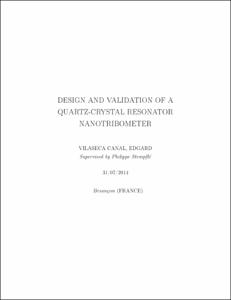Mostra el registre d'ítem simple
Design and validation of a quartz-crystal resonator nanotribometer
| dc.contributor | Stempflé, Philippe |
| dc.contributor.author | Vilaseca Canal, Edgar |
| dc.date.accessioned | 2014-10-20T16:30:03Z |
| dc.date.available | 2014-10-20T16:30:03Z |
| dc.date.issued | 2013 |
| dc.identifier.uri | http://hdl.handle.net/2099.1/23166 |
| dc.description.abstract | Design and validation of a quartz-crystal resonator nanotribometer. This report presents the design and construction of a Nanotribometer using the bibliography provided and integrating new ideas to increase the field of research in the future. It initially shows a brief summary of the functioning and the history of the Quartz Crystal Microbalance (QCM). This, at first, was used only for studies on the change of mass deposited on the surface of the resonator from the displacement of the resonance frequency. Then, in 1986 by Krim and Widom, the QCM was used for studies of friction where, taking into account the variation of frequency, also took into account the variation of the quality factor (Q-factor). This quality factor is directly proportional to the energy dissipation between the surface of the resonator and micro-objects deposited. After explaining the basic operation of the QCM and its history, presents existing models to date to evaluate and better understand the behavior of friction in different cases of the samples. Is observed in models where there is a sufficiently large contact surface, the frequency shift is negative. However, if the surface is small, the displacement of the frequency is positive. The goal is to build a Nanotribometer able to study the friction from the interaction of micro-objects placed on the surface of the resonator. With the help of the literature and the experts in the various fields were designed and purchased various items to build the equipment. One can imagine that will be required a resonator (quartz crystal), a device capable of exciting and analyze the response of the latter (Network Analyzer), the microobjects (polystyrene micro-spheres), a system for the vacuum to reduce the influence of the air in response, a system for capturing images and a magnification, and finally a structure capable to assemble all the latter. Finally, in order to verify that this Nanotribometer meets the requirements have been carried out a number of different tests of the devices and it is observed that everything works properly and that the objective has been met within budget and time available for the project. |
| dc.language.iso | eng |
| dc.publisher | Universitat Politècnica de Catalunya |
| dc.publisher | École Nationale Supérieure de Mécanique et des Microtechniques de Besançon |
| dc.subject | Àrees temàtiques de la UPC::Enginyeria electrònica::Instrumentació i mesura |
| dc.subject | Àrees temàtiques de la UPC::Enginyeria electrònica::Microelectrònica |
| dc.subject | Àrees temàtiques de la UPC::Enginyeria dels materials::Assaig de materials |
| dc.subject.lcsh | Quartz crystal microbalances |
| dc.subject.lcsh | Nanostructured materials -- Microscopy |
| dc.subject.lcsh | Friction -- Measurement -- Equipment and supplies |
| dc.subject.lcsh | Tribology |
| dc.title | Design and validation of a quartz-crystal resonator nanotribometer |
| dc.type | Master thesis (pre-Bologna period) |
| dc.subject.lemac | Microbalances de cristall de quars |
| dc.subject.lemac | Materials nanoestructurals Microscòpia |
| dc.subject.lemac | Fricció -- Mesurament -- Aparells i instruments |
| dc.subject.lemac | Tribologia |
| dc.rights.access | Open Access |
| dc.audience.educationlevel | Estudis de primer/segon cicle |
| dc.audience.mediator | Escola Tècnica Superior d'Enginyeria Industrial de Barcelona |
| dc.provenance | Aquest document conté originàriament altre material i/o programari no inclòs en aquest lloc web |
| dc.audience.degree | ENGINYERIA INDUSTRIAL (Pla 1994) |
| dc.description.mobility | Outgoing |


